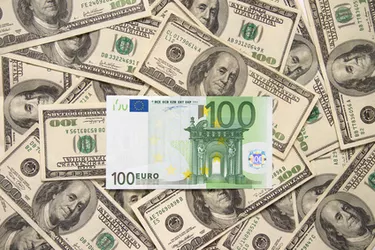
LIBOR stands for London Interbank Offered Rate and it is the interest rate at which banks lend money to each other. It is produced daily by the British Bankers' Association (BBA) in London. The rate affects mortgages, student and small business loans. Libor is calculated for 10 major world currencies at 15 maturities each, so when calculating your Libor, you need to know which currency your loan is in and its maturity period.
Step 1
Find out in which currency your loan has been taken and its maturity. Ask your bank for these details. Libor is actually a group of rates for 10 participating currencies, including the U.S. dollar, the euro, the British pound and the Canadian dollar. There are 15 rates for each currency, depending on their maturity and varying from overnight to one year. That means that Libor is 150 rates produced every business day.
Video of the Day
Step 2
Calculate the total amount of interest you will have to pay on your loan. Lenders use the following formula: principal x (Libor rate/100) x (actual number of days in interest period/360). According to USA Today, a typical adjustable rate mortgage (ARM) in the USA is based on a six-month Libor plus 2 to 3 percentage points. So when calculating the rate you have to pay, use this formula and include the extra percentage points.
Step 3
Work out your exact rate, based on this example listed on the Mortgage Professor website. This is based on a six-month Libor adjustable rate mortgage: A lender offered the ARM at 3 percent and a margin of 1.625 percent. This means that after the first six months, the new rate will be 1.625 percent plus the six-month Libor at that time. If Libor at that time is, for example, 2.625 percent, the new rate will be 1.625 + 2.625 = 4.25 percent. This can be reduced if there is an adjustment cap that limits the size of rate changes. If that cap is, say, 1 percent, the new rate will be only 3 + 1 = 4 percent.
Tip
Before you work out your particular rate, it helps to know how your Libor is calculated. For each currency there is a panel made up of a group of at least eight major banks that submit to BBA their expectations on the rates they wish to charge for lending to, or they think they will have to pay for borrowing money from other banks. In the case of the U.S. dollar the panel consists of 16 banks. The BBA then discards the four highest and the four lowest quoted rates, and then works out the average of the remaining eight quotes. The same process applies to each maturity and each participating currency.
Warning
Libor rates are influenced by central bank rates, banks’ expectations on future rate movements and general sentiment about global economy. This means that despite improvements in one country or part of the world, Libor can go up because of problems in another part of the world.
Video of the Day